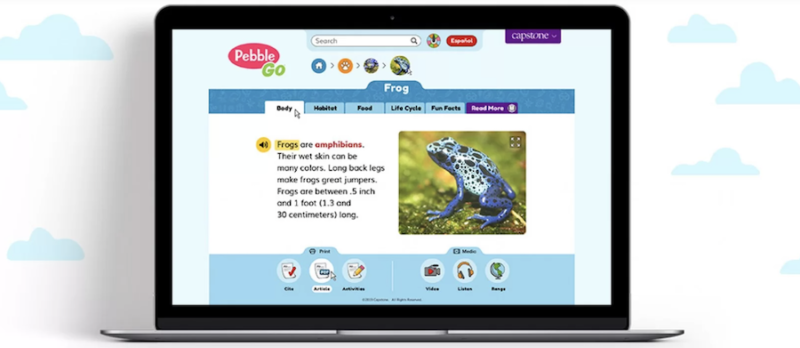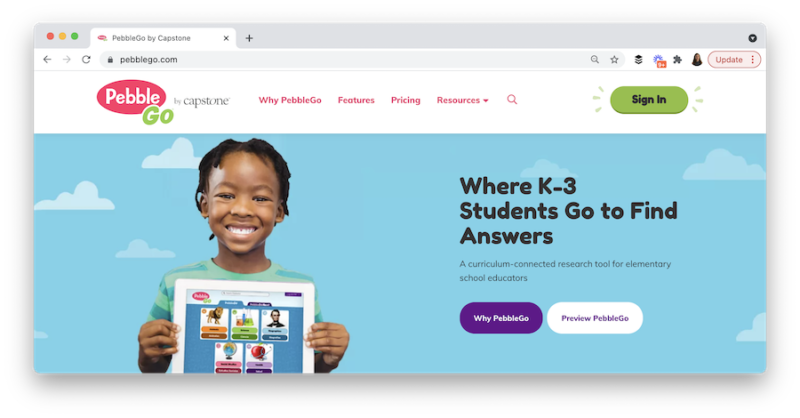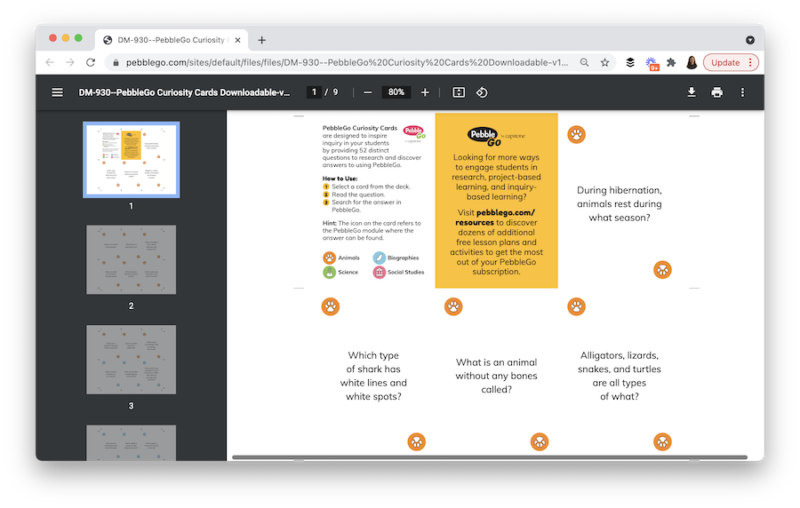If you’ve spent time in a classroom with students of any age, you know that questions can pop up throughout lots of different conversations. But how can we help students, especially our youngest students, build a sense of wonder about the world around them? How can we help tap into intellectual curiosity as students explore new topics?
We want to create spaces where students feel comfortable asking questions. Where they can share their wonderings and feel comfortable as they dig deeper to learn more about a topic. Curiosity is an important component of lifelong learning, and we can help students build this muscle at a young age.
In today’s blog post, I want to unpack the term intellectual curiosity. I’ll share some strategies that you can use to help students build skills around asking deep questions. We’ll also take a look at some of the fantastic resources from PebbleGo. Their articles and teacher resources (like Curiosity Cards) can help you tap into intellectual curiosity this school year!
What is intellectual curiosity?
Intellectual curiosity is the act of asking questions to learn something new. There is a mission behind a wondering. Students want to find the answer to a question and are hungry to learn more. Some students ask lots of questions and work to search for answers when they want to know more about a topic.
Although older students may have more opportunities to take on independent research projects or choose specific topics to explore, it is crucial to provide younger students with experiences related to curiosity. Building these skills at an earlier age can help students throughout their school years and beyond. A variety of research supports this idea that curiosity is “one of the strongest markers for success” — here’s an overview from Scott Barry Kaufman at The Atlantic.

Activities to Promote Intellectual Curiosity
Here are a few strategies and activities to consider to help students develop intellectual curiosity.
Model Questioning
Let students see you wonder. This commitment to modeling could include questions you plan ahead of time to “think aloud.” You can use these questions when reading a short passage or article to students. For example, you might prepare a few questions before reading an article aloud to students. Then, let students hear your thought process as you wonder, similar to how you might model a reading skill to your group.
Carve Out Time
Build time into your schedule for students to think deeply about a topic or something you’ve read together. There are already so many full parts of the day already. Try not to think of this practice as another thing to add to your schedule. Instead, think of moments you might already have during the day when this can become part of your routine. For example, you might have students pause to think about questions they have and share them during a turn and talk or morning meeting.
Record Wonders
Give students a space to jot down their lingering questions about a topic. You might try this out with a tool like Flipgrid, where students can record their questions and post a video for their classmates to see. Or you might have students use a digital space like Seesaw. They can draw a picture and record their voice to keep track of their questions.
Place Value on Questions
Although you might not have time to answer every question that comes up as students read independently, in pairs, or as a whole class, you can still show students that their questions are valued. This practice could include using phrases like, “I noticed how you are wondering deeply about what you have read…” or “It’s wonderful to hear you asking so many questions…” or “Make sure to jot down your questions in our wondering notebook…”

What does intellectual curiosity look like in a classroom?
The idea of curiosity is one I’ve shared both here on the blog and in my book Tasks Before Apps (ASCD), where I have an entire chapter dedicated to the concept of curiosity. Here’s an excerpt from page 41:
“A curious student who can imagine multiple solutions to a problem is equipped to innovate when presented with challenges both inside and outside the classroom… As students explore their interests and move through content with a passionate teacher by their side, they become actively engaged in learning.”
Bringing intellectual curiosity into your classroom requires a plan. In addition to the strategies listed above, you can pair your commitment to exploring intellectual curiosity in your classroom with the fantastic resources from PebbleGo.
Intellectual Curiosity and PebbleGo
PebbleGo gives students and teachers access to high-interest informational text explicitly designed for elementary school-aged students. These texts are perfect for helping students dive into a wide range of topics that will spark their curiosity and lead them to ask questions. Regular readers of the blog may remember how I’ve spotlighted PebbleGo a few times in the past (like this post). I am a big fan of this online resource for K-3 teachers and students.

The articles in PebbleGo connect so well to this idea of intellectual curiosity. To help students build the capacity to dive deeper into a topic, you can introduce short texts from PebbleGo and give students space to ask questions and look for answers. In addition, there are ready-to-use resources from PebbleGo to support intellectual curiosity. For example, the 50+ PebbleGo Curiosity Cards support four of the modules within PebbleGo, including Animals, Science, Biographies, and Social Studies.
To help facilitate this type of questioning activity with PebbleGo, I encourage you to check out the PebbleGo Curiosity Cards. Educator Shannon McClintock Miller wrote a blog post that shared great tips for using this resource.
As you explore the topic of intellectual curiosity this school year, check out the high-interest, high-quality resources from PebbleGo. Head over to this page to learn more about PebbleGo and see all of the articles they have for students to explore!







